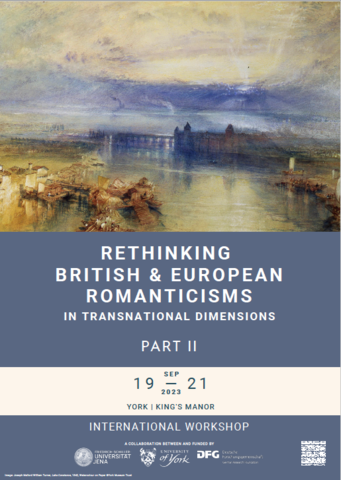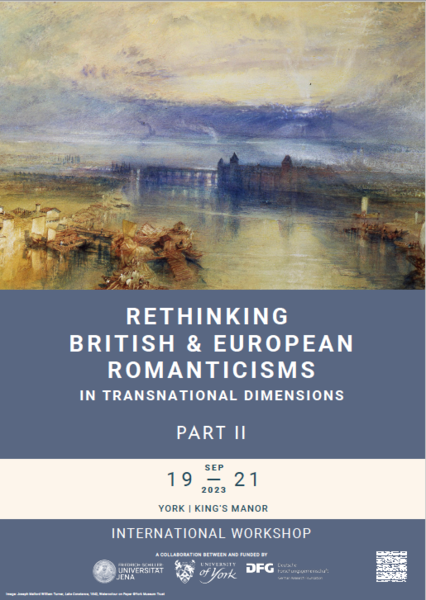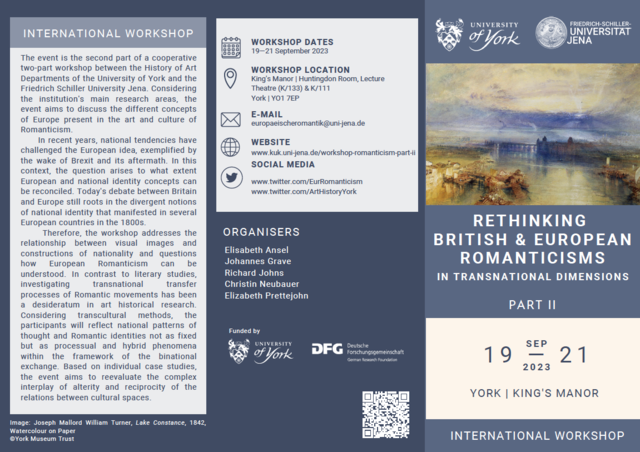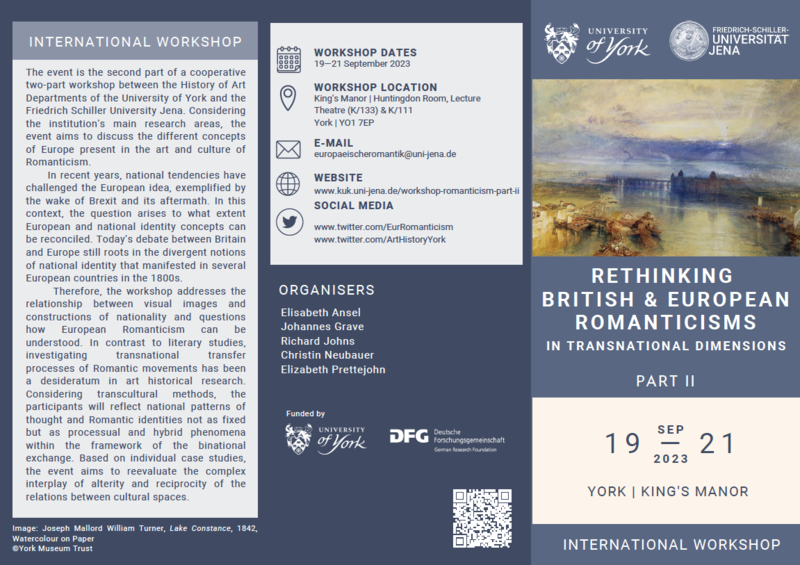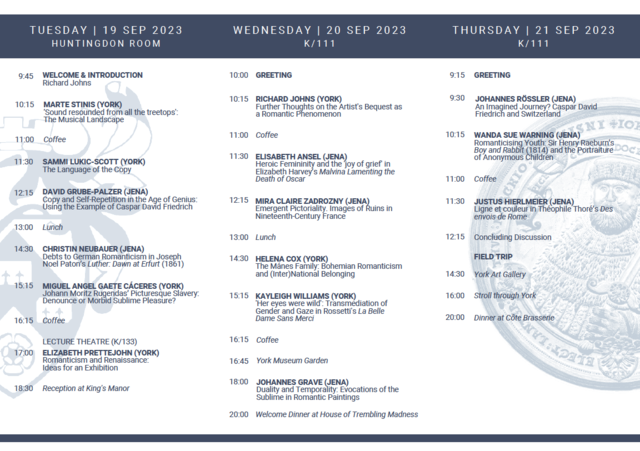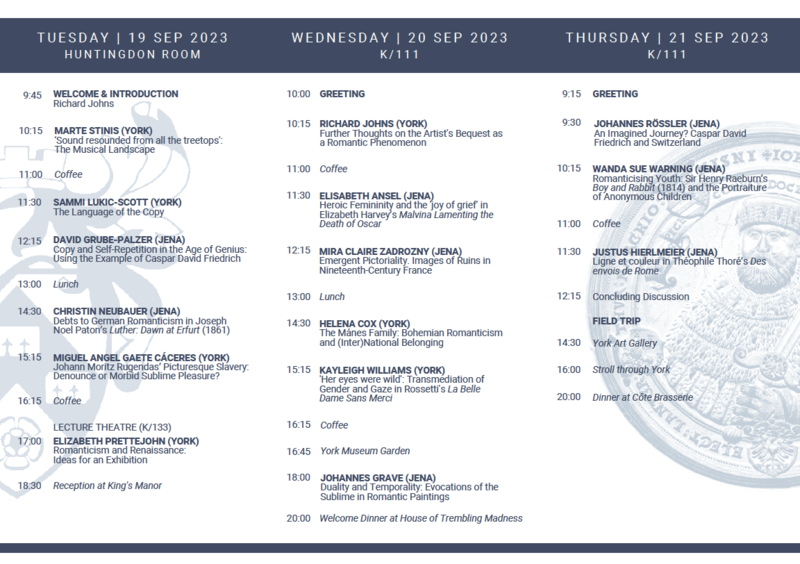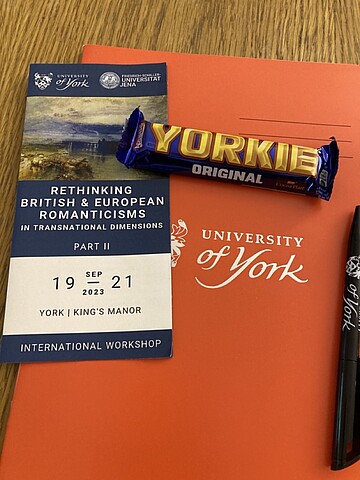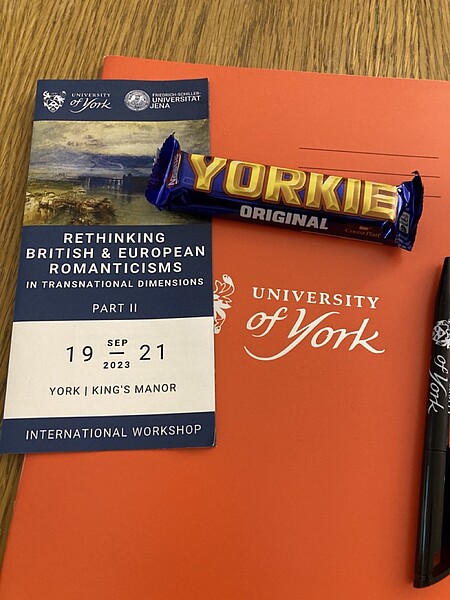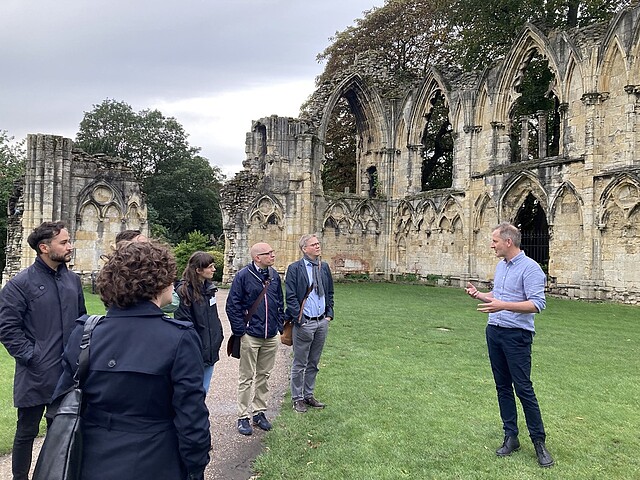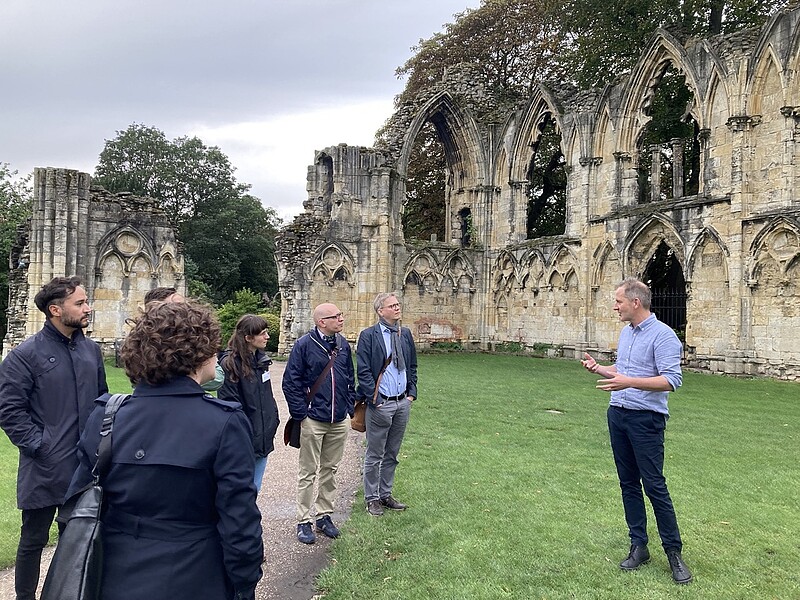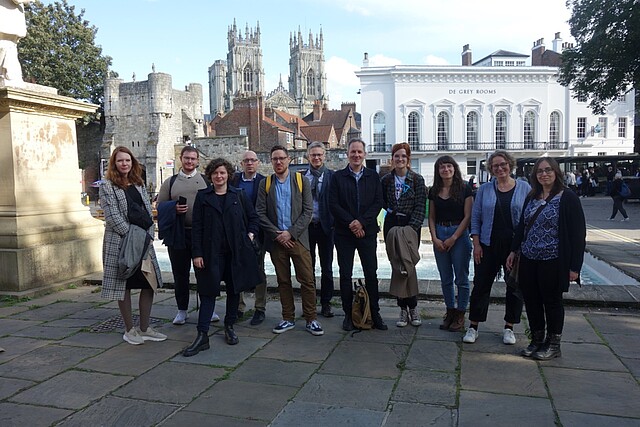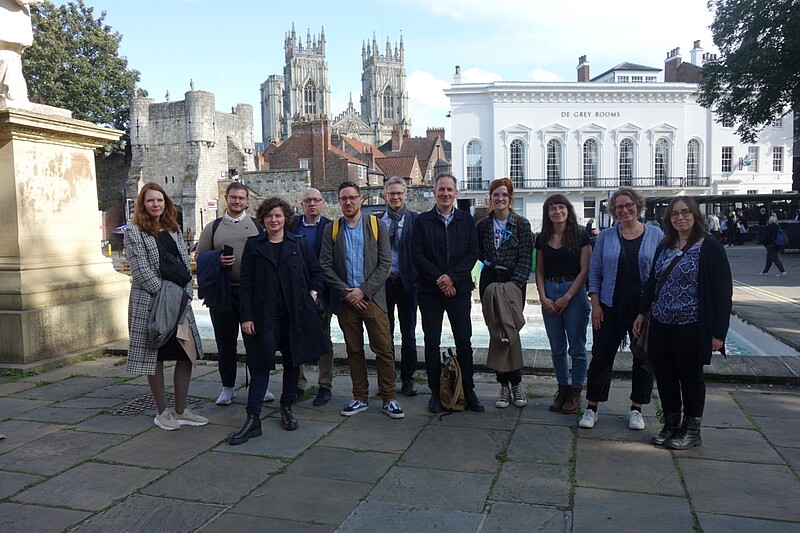„Rethinking British & European Romanticisms in Transnational Dimensions - Part II“
From the 19th to the 21st of September 2023, University of York’s King’s Manor hosted the second part of the workshop Rethinking British & European Romanticisms in Transnational Dimensions, an international partnership between the History of Art Departments of the University of York (UK) and the Friedrich Schiller University of Jena (Germany) after a fruitful workshop that took place in Jena in late March 2023. The two universities joined forces to discuss and exchange their perspectives and developments on the study of the international implications and the cultural intersections that characterised Romanticism throughout the long nineteenth century in Europe and beyond. The second part of the workshop was organised by Elisabeth Ansel (Jena), Johannes Grave (Jena), Richard Johns (York), Christin Neubauer (Jena) and Elizabeth Prettejohn (York) and funded by the German Research Foundation (DFG) and the History of Art Department (YAHCs – York Art History Collaborations) of the University of York.
The workshop commenced with Marte Stinis (York) delving into her paper ‘Sound resounded from all the treetops’: The Musical Landscape. Stinis explored the Romantic notion of landscapes as musical experiences, drawing from Felix Mendelssohn’s Overture in B minor, op. 26, The Hebrides. This piece aims to evoke the auditory impressions of water crashing on Scottish cliffs highlighting the Romantic belief in imaginative creativity. During the 1830s, when the artistic developments of Corot and the mature works by Turner flourished, the link between landscape and music gained prominence. These painters, akin to Mendelssohn’s modus operandi, infused their works with the vivacity of music, fostering a contemplative, emotional, and almost symphonic experience of nature. Charles Baudelaire, Theophile Gautier and Hyppolite Thaine, debating the interplay between landscape and music, inspiring James McNeill Whistler to evoke ‘synesthetic’ experiences through paintings in their viewers. By adopting titles with musical allusions (Nocturne, Symphony…), Whistler encouraged viewers to engage emotionally and musically with landscapes, capturing the essence of musical spatiality and temporality, and thereby epitomising the Romantic evolution of musicality of nature into a synesthetic artistic discourse.
The second part of the morning investigated the role, agency, reproduction, and consumption of copies in the decade of Romanticism. In her presentation The Language of the Copy, Sammi Lukic-Scott (York) aimed to revaluate the concept and role of copies as a crucial medium in cultural exchange, highlighting their transformative power inherent in the act of visual replication of trans-mediation of both visual and non-visual works. However, a closer examination of ‘copies’ reveals meticulous attention to detail, demonstrating therefore the dual nature of copying: it can either serve as a direct translation of the original, establishing an authentic connection, or as a reinterpretation, leading to profound alterations in the object’s structure and function.
David Grube-Palzer (Jena) concluded the session with his paper Copy and Self-Repetition in the Age of Genius: Using the Example of Caspar David Friedrich. He examined the role of copy in Friedrich’s artistic practice, notably examining instances like his replication of his own artworks (e. g. Two Men Contemplating the Moon). Grube-Palzer questioned whether these multiple versions were mere studio copies, perhaps commissioned by patrons, or driven by the artist’s financial struggles, indicating a practical need to sell his works. This ambiguity is further exemplified in Friedrich's Winter Landscape (c. 1811) and its replication Winter Landscape with Church (1812–13) by Karl Wilhelm Lieber, which led to their estrangement. The analysis illuminates the complex dynamics of copying by reflecting the intricate interplay of artistic intention, financial constraints, and social dynamics in the art world.
The paper of Christin Neubauer (Jena), Debts to German Romanticism in Joseph Noel Paton’s ‘Luther: Dawn at Erfurt (1861), examined how Pre-Raphaelitism, despite being perceived as an exclusively British phenomenon, appropriated German cultural stimuli from the nineteenth century. Neubauer discussed how figures like Ford Madox Brown acquainted young painters with works by the Nazarenes, broadening the rich tapestry of intercultural dialogue and artistic exchange. She used Joseph Noel Paton’s as a prime example of a Pre-Raphaelite work deeply rooted in German history and art history. Paton’s painting references Albrecht Dürer’s iconic engraving of St. Jerome in his study (1546), but the reference also seems to have been inspired by the rising interest in the German theologian that developed in Britain in the 1860s. In addition to the motif, various formal-aesthetic traits like narrow image spaces, vertical emphasis and linear compositions are adopted in Pre-Raphaelitism, reflecting a resonance with German Romanticism on a visual level. This nuanced engagement with German art exemplifies Pre-Raphaelitism’s intricate relationship with foreign cultural influences.
Miguel Gaete (York) concluded the second session with his paper Johann Moritz Rugenda’s Picturesque Slavery: Denounce or Morbid Sublime Pleasure?, investigating Rugenda’s imagery of enslaved and indigenous people in his illustrated volume Malerische Reise in Brasilien – Voyage pittoresque dans le Bresil. Gaete challenged the prevailing interpretation of the artist’s art as a denouncement of black slavery in Brazil. Instead, Gaete dissected the complexity of Rugendas’s images by interpreting them as deeply influenced by the concept of the sublime and the idea of pain as a source of ‘delight’ as discussed by Edmund Burke in 1757. Gaete questioned Rugendas’s use of Christian imagery, discussing if it was for profit or genuine empathy towards slaves, prompting profound reflections on his stance on slavery. By analysing the illustrations phenomenologically, Gaete explored if the artist aimed to evoke the emotional tension of the sublime, drawing from Romantic ideals. This investigation revealed layers of colonial voyeurism in Rugendas’s work, complicating his artistic intentions regarding power and control.
The first day of workshop concluded with Elizabeth Prettejohn’s (York) talk on Romanticism and Renaissance: Ideas for an Exhibition, in conversation with Christin Neubauer. They discussed the upcoming extensive and sumptuous exhibition Pre-Raphaelites: Modern Renaissance (Preraffaelliti: Rinascimento Moderno), scheduled for the first half of 2024 at the Musei di San Domenico (Forlì, Italy). As one of the curators, Prettejohn explores the profound impact of Italian art on the British Pre-Raphaelite movement, a topic still relatively unexplored in Italian scholarship. The exhibition will juxtapose an extensive selection of Italian and British artworks from the 1840s to the 1920s and will also feature Italian Medieval and Renaissance artworks in comparison to nineteenth-century British paintings, revealing the significant impact of British Pre-Raphaelitism on Italian art at the fin de siècle.
The second day of the workshop focused on various perspectives on the perception of objects, phenomena, and images. Richard Johns (York) opened the day with Further Thoughts on the Artist’s Bequest as a Romantic Phenomenon. He emphasised that a more extensive collection doesn’t necessarily provide a deeper understanding of an artist. The vastness of the Turner Bequest gives a glimpse into Turner’s extensive output, yet its disorder poses challenges in curation and interpretation. Johns compared art preservation to granting eternal life, drawing parallels to astrophysical concepts like gravitational force and space-time distortion. He also explored the notion of ‘unfinished’ art, discussing its identification and significance within an artist’s body of work. Through rich insights and references, Johns prompted reflection on art’s evolving condition after an artist’s death, drawing inspiration from Gary Schwartz’s work on art’s mortality. His presentation offered a nuanced understanding of the complexities of preserving and interpreting art for posterity, emphasizing its significance in national framing.
Elisabeth Ansel (Jena) delivered a captivating presentation on Heroic Femininity and the 'joy of grief' in Elizabeth Harvey's 'Malvina Lamenting the Death of Oscar', delving into the intriguing world of Romantic paintings centred around the Ossian theme. Ansel's paper challenged the predominant focus on heroic masculinity in such artworks, particularly spotlighting Harvey’s painting, Malvina Lamenting the Death of Ossian. Contradicting conventional norms, the artist’s painting features a female protagonist as the central figure in this visual adaptation of the Ossianic narrative, diverging from the traditional portrayal of women merely as companions. Ansel delved into European Romanticism’s visual exchanges, tracking the dissemination of the Ossian myth through James McPherson’s writings. Stressing Harvey’s innovation, Ansel highlighted the repositioning of Malvina in her narrative, symbolising female empowerment. Drawing parallels with classical art like Kauffmann’s Penelope, Ansel showcased Harvey’s thorough research and cross-cultural influences. Additionally, Ansel noted the international recognition of Harvey’s work, evident in its print reproduction, a rare honour from the Salon exhibitions. Overall, the analysis shed light on gender dynamics and artistic reinterpretation in Romantic painting.
In her presentation, Emergent Pictorality: Images of Ruins in Nineteenth-Century France, Mira Claire Zadrozny (Jena) delved into the intricate interplay between aesthetics, perception, space and temporality as manifested in depictions of ruins in art. Zadrozny explored how artists like Tirpenne and Berthelon use imagery to create atmospheric ruins, drawing from Böhme’s theory of the atmospheric. She emphasised the emergent and immersive qualities of these representations, highlighting their temporal aspect and the dynamic reception process. Using examples like Ruines de la Cour des Comptes, she showed how ruins evoke spatial and temporal dimensions, prompting viewers to ponder both the ageing process depicted and the medium itself. Additionally, Zadrozny examined how different mediums, such as oil paint in Courbet’s Château d’Ornan, can evoke immersive or emergent effects through their treatment of materiality. The decaying wall in the picture reveals pasty paint applied with a palette knife. This technique can engender immersive effects and also evokes emergent effects, wherein the palpable materiality of the paint itself takes precedence, inviting viewers into a deeper contemplation of texture and surface.
Helena Cox’s (York) paper, The Manés Family: Bohemian Romanticism and (Inter)national Belonging, centred on the works of the Czech artist family active from the 1820s to the 1870s. She highlighted Josef Mánes and his sister Amálie Mánesová as key figures of Bohemian Romanticism. Cox investigated the divide between ‘Eastern’ and ‘Western’ European art history, drawing from recent works by Rampley and Piotrowski’s concept of a ‘horizontal’ art history. Despite J. Mánes’s popularity in Czechia, his international recognition is hindered by regional biases, where Bohemian art is often seen as derivative of Western styles. Cox compared the Manes family’s work to German artists, highlighting Josef Mánes’s German influences while aiming to establish a unique Bohemian style. She also examined nationalism in Romanticism and proposed strategies for integrating Central and Eastern European art into the broader Western art historical narrative.
Kayleigh Williams (York) delivered the second paper, titled “Her eyes were wild”: Transmediation of Gender and Gaze in Rossetti’s La Belle Dame sans Merci”. She explored the intricate relationship between John Keats’s poetry and Pre-Raphaelitism. While Keats’s poetry profoundly inspired the Pre-Raphaelite Brotherhood, Williams’s paper shed light on the challenges they faced in translating Keats’s poetic imagery into visual representations. She notably examined Dante Gabriel Rossetti’s struggle in transmediating Keats’s work, particularly La Belle Dame sans Merci, into visual representations, particularly depicting the enigmatic female protagonist. Through her analysis, Williams offered insight into the complexities of gender portrayal and visual interpretation within the context of Rossetti’s artistic endeavours.
Johannes Grave (Jena) focusing in the final contribution of the day on Duality & Temporality: Evocations of the Sublime in Romantic Painting evoked by the sublime. His paper examined two paintings, Friedrich’s The Monk by the Sea (1808–10) and Turner’s Shade and Darkness: The Evening of the Deluge. Grave investigated how these artists portrayed the sublime, emphasizing the distinction between the viewer’s perception of the object itself and what they desire to see in it. Considering Kant’s concept of the mathematical sublime, Grave differentiates between the ‘comprehension’ of the image (how objects are perceived) and ‘apprehension’ (how the object is perceived in its entirety). He argued that Friedrich’s work blurs this distinction, challenging the viewer’s perception of immensity and reality. In contrast, Turner’s painting emphasises material aspects of the artwork, such as transparency and opacity. Grave concluded that both artists construct magnitude to evoke the sublime, with Friedrich embodying Kant's ‘rational’ or ‘mathematical sublime', while Turner expresses it through the artistic sensibility. These examples highlight the complex interplay between the perception of the object, artistic representation, and the expression of the sublime in Romantic painting.
The final day commenced with Johannes Rößler’s (Jena) An Imagined Journey? Caspar David Friedrich and Switzerland, which investigated Friedrich’s misty landscapes that captivated his contemporaries with their mysterious and evocative portrayal of nature. Rößler proposed that the artist’s series of misty landscapes stemmed from an ‘imaginary journey’ through Switzerland, inspired by Goethe’s Letters from Switzerland. Despite being influenced by emerging currents in landscape painting developing in Dresden in the early nineteenth century, Friedrich may have drawn upon Goethe’s thematic exploration of the meteorological phenomenon of fog as a medium for human-landscape interaction that resonated with his vision. Facing financial hardship, Friedrich might have reacted to Goethe’s fascination with fog to craft his personal rendition of atmospheric and landscape phenomena. Rößler illustrated his argument by comparing Friedrich’s Mountain Landscape with Rainbow with Goethe’s recollection of the same atmospheric phenomenon observed in Switzerland.
The session concluded Wanda Sue Warning’s (Jena) paper Romanticism Youth: Sir Henry Raeburn’s Boy and Rabbit (1814) and the Portraiture of Anonymous Children. Warning investigated the portrayal of anonymous children by Raeburn, using his painting Boy and Rabbit (1814) as a prime example for her argumentation. She demonstrated the artistic freedom evident in Raeburn’s work, showcasing his willingness to capture sentimental depictions of nameless children. By comparing Boy and Rabbit with Sir Joshua Reynolds’s ‘fancy pictures’ and the ‘tronies’ by the Dutch painter Frans Hals – namely a type of portrait that aimed to record the facial expressions of the person depicted – Warning contextualized Raeburn’s work within a broader artistic tradition. This contrast highlights the global influences shaping Raeburn’s unconventional and emotionally resonant depiction of children. The analysis underscores the importance of Raeburn’s method in capturing the innocence and charm of unidentified young subjects, enriching our grasp of Romantic portraiture.
Justus Hierlmeier (Jena) delivered the concluding talk: Ligne et Couleur in Théophile Thoré’s ‘Des Envois de Rome’. His presentation investigating the intersection of painting styles and political implications linked to these styles and between art and politics in early-nineteenth-century France. Hierlmeier analysed Thoré’s discussion on the state of French painting and the contrasting styles of Jean-August-Dominique Ingres and Eugène Delacroix, highlighting the political undercurrents shaping French art. Thoré critiqued Ingres’s ‘linear’ style as dry, contrasting it with Delacroix’s ‘painterly’ approach, which he lauded for its passion and innovation. In his view, Ingres’s success was tied to the politicisation of art, culminating in his appointment as director of the Académie de France in Rome. Hierlmeier’s analysis of Thoré’s views provides insight into the intricate connection between artistic styles and political dialogue in early-nineteenth-century France.
Scholars explored during the three workshop-days Romanticism’s intersections with music, visual art, and literature, alongside its ties to perception, temporality, and the sublime. Through insightful presentations and analyses, participants unveiled Romanticism’s multifaceted influence, emphasising international cooperation in cultural understanding. This collaborative effort underscored Romanticism’s enduring relevance in contemporary scholarship, illuminating familiar themes and hidden connections across borders and disciplines.
